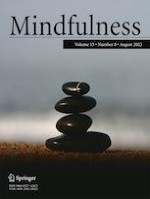07-07-2022 | ORIGINAL PAPER
Adolescents’ Experiences of Distress and Well-being During Intensive Mindfulness Practice: A Mixed-Methods Study
Gepubliceerd in: Mindfulness | Uitgave 8/2022
Log in om toegang te krijgenAbstract
Objectives
In recent years, mindfulness has gone mainstream, reaching many adolescents through school programs and smartphone applications. Yet there is little empirical understanding of what mindfulness practice is like for adolescents. This mixed-methods study sought to capture adolescents’ lived experiences as they embarked on a period of intensive mindfulness practice.
Methods
Twenty-three self-selected youth (Mage = 16.68 years, SD = 1.55; 57% girls, 43% boys; 52% White, 13% African American, 4% Latino, 4% East Asian, and 26% Multiracial) participated in a 6-day residential mindfulness retreat. Participants completed self-report surveys, open-ended daily diaries, and discussed their experiences in focus groups. Qualitative data were analyzed using a two-cycle coding process to categorize common patterns of adolescents’ experiences during mindfulness practice and quantitative data were examined for demographic subgroup differences.
Results
Adolescents reported an array of experiences of distress from cognitive (83% of adolescents; e.g., self-loathing and rumination), to emotional (87% of adolescents; e.g., sadness), and to physical distress (44% of adolescents; e.g., physical pain) during mindfulness practice. They also described a range of well-being experiences from cognitive (87% of adolescents; e.g., self-inquiry and discovery), to emotional (65% of adolescents; e.g., acceptance), and to social well-being (39% of adolescents; e.g., loving-kindness and connection). The frequency of experiences of distress and well-being reported were relatively balanced overall, yet girls and experienced meditators reported greater distress.
Conclusions
This study paints a descriptive picture of adolescents’ experiences during mindfulness practice and suggested that their experiences might reflect core developmental concerns. Implications for adolescent development and contemplative science are discussed.
